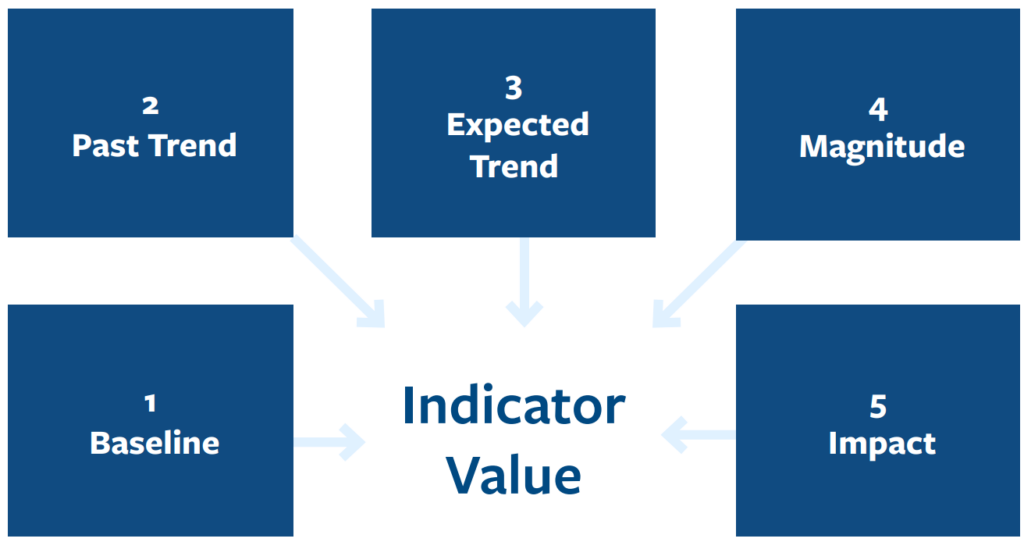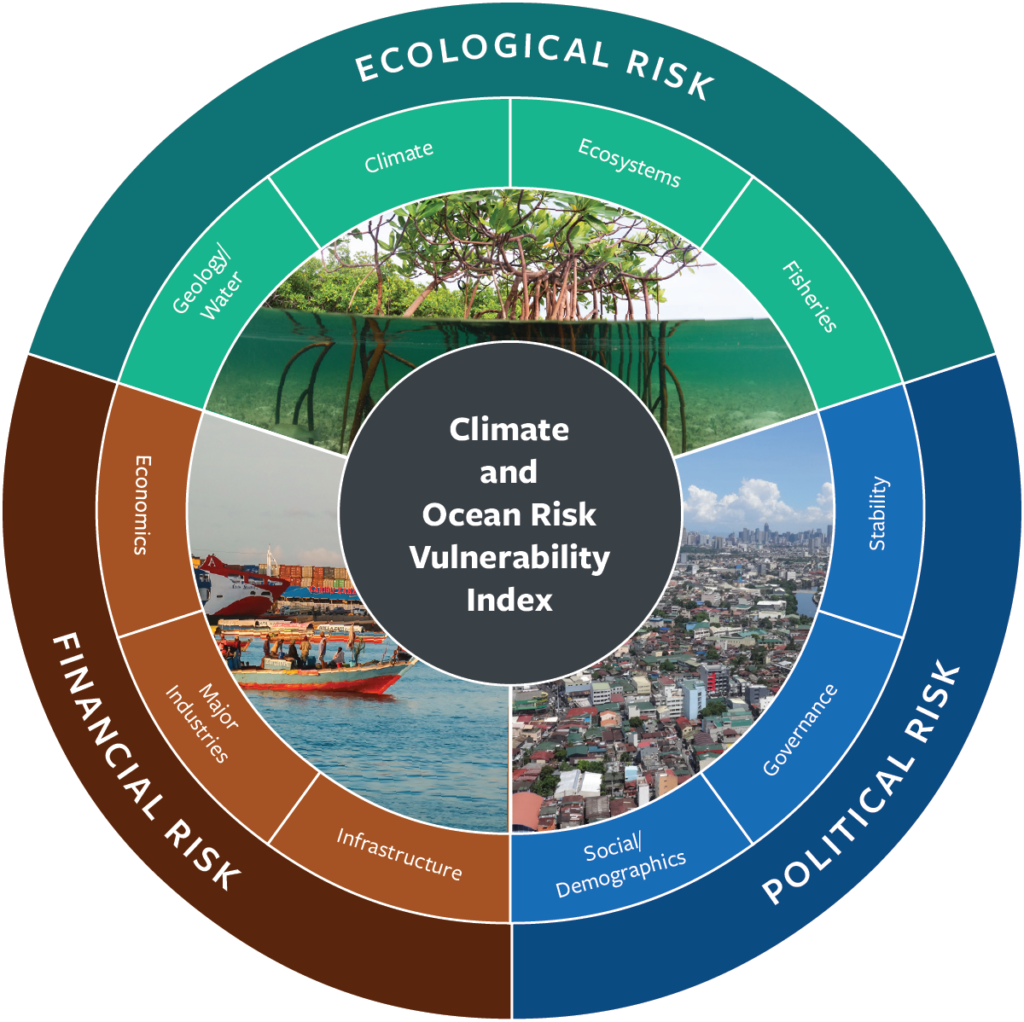Indicators & Methodology
CORVI is a decision support tool which compares a diverse range of ecological, financial, and political risks connected to climate change, to produce a coastal city or island state risk assessment. This information can be used to identify and categorize risk across sectors, aid in the design of integrated policy solutions, and access climate investment to build resilient coastal cities and island states.
For more information, please see our academic paper, ‘The climate and ocean risk vulnerability index: Measuring coastal city resilience to inform action’, published in Frontiers in Sustainable Cities.
Risk Indicators: What CORVI Measures
CORVI risk indicators are grouped in 10 categories under three risk areas: ecological, financial, and political/social. Each category is made up of multiple indicators – close to 100 in total – covering a range of issues from the vulnerability of vital infrastructure and the health of marine ecosystems, to urbanization dynamics in the chosen coastal city or island state.
Each category and indicator are scored on a 1-10 scale, with 10 indicating greatest risk. Together, these indicators identify the areas of greatest risk so that decision makers can build resilience where it is needed most.
Coastal cities are heavily dependent on both terrestrial and marine environments for their safety and economic security. Ecological risks, such as ecosystem health, the state of near and offshore fisheries, and geographical factors such as coastal erosion provide important metrics to understand the environmental changes faced by coastal cities.
Low risk scores mean that either the coastal city or island state has successfully built resilience in the issue area or the indicator is not as relevant for understanding risk in that city.
Medium risk scores indicate that while resilience has been built to address the specific risk, future changes could destabilize resilience gains.
Medium-High risk scores mean that current measures are insufficient and more attention is required to build resilience against future climate security impacts.
High risk scores indicate that the issue area represents a key threat to the coastal city or island state with the potential to undermine the security of its residents.
Methodology
Indicators
To ensure that the CORVI indicator scores provide a holistic risk rating, each indicator comprises five factors: current, past, and expected trends, the rate of change of the risk, and the impact of this risk on the coastal city or island state.
- The BASELINE measures the current level of risk for each indicator relative to other coastal cities and island states in the region. Baseline data for economic and social indicators are derived from the most recent year of complete data. Climate indicators use an extended time period of 15 years.
- PAST TREND assesses the trend of risk for the past 10 years, measured from the baseline year. The only exception to the 10-year trend measure is the climate indicators, which use a 15-year trend horizon to account for slow-onset changes.
- EXPECTED TREND assesses the anticipated trend of risk in the next 10 years, measured from the baseline year. The only exception to the 10-year trend measure is the climate indicators, which use a 15-year trend horizon to account for slow-onset changes.
- MAGNITUDE assesses the degree of expected future trend change relative to other cities in the region. Change that happens more quickly than expected are assumed to increase risk when compared to changes that take place over a longer time scale. This assumes that longer periods of change contribute to less risk, as decision makers have more time to adapt and build resilience.
- Finally, IMPACT assesses the importance of change for each indicator in describing future risk in the coastal city or island state.

Data Collection and Structured Expert Judgement
To overcome data gaps, CORVI employs structured expert surveys to collect data that is otherwise unavailable. This primary data is combined with secondary data using structured expert judgment (SEJ) to produce a comparative score for each indicator in the assessment.1 For an introduction to structured expert judgment, see Cherie Maestas, “Expert Surveys as a Measurement Tool: Challenges and New Frontiers,” in The Oxford Handbook of Polling and Survey Methods, eds. Lonna Rae Atkeson and R. Michael Alvarez (Oxford: Oxford University Press, 2018). SEJ is a well-established social science technique that seeks to quantify risk when preexisting secondary data is inadequate. Through interviews and surveys, as well as a series of weighting procedures to ensure that data is representative, SEJ allows researchers to quantify topics that might otherwise be challenging to study in such a systematic fashion.
To apply SEJ to CORVI, subject matter experts across academia, government, civil society, and the private sector are identified through research and extensive outreach to stakeholders in the target coastal cities and island states. These experts then refer the project team to other experts and stakeholders with appropriate expertise using “snowball sampling.”2 Snowball sampling or chain-referral sampling is a non-probability sampling technique used when samples have traits that are difficult to find. In this sampling technique, existing subjects provide referrals to recruit additional subjects required for a research study To guard against confirmation bias, survey answers are compared to a regional secondary empirical dataset to weigh the expert responses by utilizing a coherence check.3 Abigail Colson and Roger Cooke, “Expert Elicitation: Using the Classical Model to Validate Experts’ Judgements,” Review of Environmental Economics and Policy 12, no. 1 (2018): 113–132. The coherence check ensures that experts whose answers do not match secondary data are not weighed as highly as those who do.
This approach has several strengths. First, CORVI incorporates the views of subject matter experts and local stakeholders at each stage of its implementation. This allows the final product to better reflect the specific context it is seeking to measure and provide more focused information for end users. Second, pairing primary survey data with secondary data through SEJ allows CORVI to provide insight into risks relating to urban coastal environments that existing secondary datasets do not cover. While the use of SEJ allows CORVI to assess a diverse range of risks, it should not be regarded as a substitute for empirical data collection. Rather, SEJ is best viewed as an alternative research technique specialized in analyzing topics with significant data gaps.4 H. Kunreuther, S. Gupta, V. Bosetti, R. Cooke, V. Dutt, M. Ha-Duong, H. Held, J. Llanes-Regueiro, A. Patt, E. Shittu, and E. Weber, “Integrated Risk and Uncertainty Assessment of Climate Change Response Policies,” Climate Change 2014: Mitigation of Climate Change. Contribution of Working Group III to the Fifth Assessment Report of the Intergovernmental Panel on Climate Change, eds. O. Edenhofer, R. Pichs-Madruga, Y. Sokona, E. Farahani, S. Kadner, K. Seyboth, A. Adler, I. Baum, S. Brunner, P. Eickemeier, B. Kriemann, J. Savolainen, S. Schlömer, C. von Stechow, T. Zwickel, and J. C. Minx (Cambridge: Cambridge University Press, 2014).

